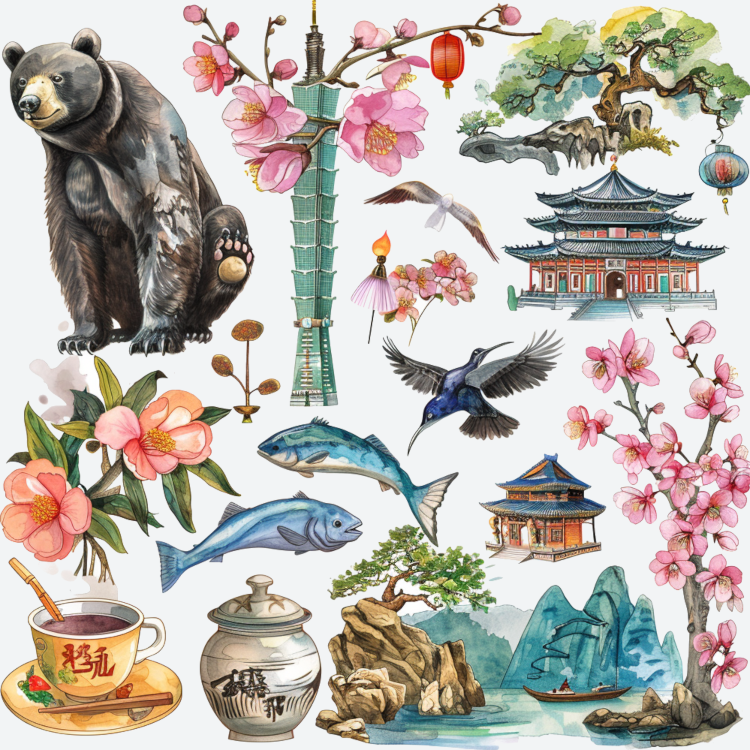
Location
Taiwan, officially known as the Republic of China (ROC), is an island located in East Asia. It is situated approximately 180 kilometers (112 miles) off the southeastern coast of mainland China, across the Taiwan Strait.
Capital
The capital city of Taiwan is Taipei.
Population
As of the latest estimates, Taiwan has a population of approximately 23.6 million people.
Area
Taiwan covers an area of about 36,193 square kilometers (13,974 square miles).
Official Language
The official language of Taiwan is Mandarin Chinese. However, Taiwanese Hokkien, Hakka, and indigenous languages are also spoken by various ethnic groups.
Government
Taiwan is a democratic republic with a multi-party system. The government operates under a semi-presidential system with a President as the head of state and a Premier as the head of government. The Legislative Yuan is the unicameral legislature of Taiwan.
Status
Taiwan is a self-governing democratic island, but its sovereignty is a subject of dispute. The People's Republic of China (PRC) claims Taiwan as its territory, but Taiwan operates with its government, military, and constitution.
Economy
Taiwan has a highly developed and export-oriented economy, primarily driven by manufacturing, technology, and trade. It is known for its electronics industry, including semiconductors and computer hardware. Taiwan is one of the Four Asian Tigers, along with South Korea, Hong Kong, and Singapore, known for its rapid industrialization and economic growth.
Currency
The currency of Taiwan is the New Taiwan Dollar (TWD).
Natural Features
Taiwan is characterized by mountainous terrain, with more than half of the island covered by forested mountains. It also has a diverse range of ecosystems, including tropical rainforests, subtropical forests, and coastal mangrove forests. Taiwan is prone to earthquakes and typhoons due to its location along the Pacific Ring of Fire.
Culture
Taiwanese culture is a blend of indigenous traditions, Chinese influences, and modern developments. It encompasses various art forms, cuisine, festivals, and religious practices. Taiwanese cuisine, including dishes such as beef noodle soup, dumplings, and bubble tea, is renowned internationally.
Infrastructure
Taiwan has a well-developed infrastructure, including modern transportation networks, telecommunications, healthcare facilities, and educational institutions. High-speed rail and extensive public transportation systems connect major cities and regions across the island.
International Relations
Taiwan maintains unofficial diplomatic relations with countries around the world, as it is not recognized as a sovereign state by the United Nations and many countries due to pressure from China. However, Taiwan participates in international organizations and maintains extensive trade and cultural ties globally.
Tourism
Taiwan is a popular tourist destination, attracting visitors with its scenic landscapes, cultural attractions, and culinary delights. Tourist highlights include the Taipei 101 skyscraper, Taroko Gorge National Park, Sun Moon Lake, Alishan Mountain, and the historic streets of Jiufen and Tainan.
National Items of Taiwan
Formosan Black Bear
The Formosan Black Bear (Ursus thibetanus formosanus) is the national animal of Taiwan. Known for its distinctive white V-shaped marking on the chest, it symbolizes strength, resilience, and the rich biodiversity of Taiwan.
Taiwan Blue Magpie
The Taiwan Blue Magpie (Urocissa caerulea) is the national bird of Taiwan. It symbolizes beauty, intelligence, and the unique avian diversity of the island.
Plum Blossom
The Plum Blossom (Prunus mume) is the national flower of Taiwan. It represents resilience, perseverance, and the beauty of enduring adversity, as it blooms in the harsh winter months.
Banyan Tree
The Banyan Tree (Ficus microcarpa) is an important symbol in Taiwan, representing longevity, stability, and the interconnectedness of life.
Milkfish
The Milkfish (Chanos chanos) is considered the national fish of Taiwan. It symbolizes the country’s rich fishing culture and culinary traditions.
Bamboo
Bamboo is a significant plant in Taiwan, symbolizing strength, flexibility, and the cultural heritage of the island.
Orchid
Taiwan is known for its rich diversity of orchids. The flower symbolizes beauty, luxury, and the island’s significant horticultural industry.
Taiwanese Tea
Tea, particularly Oolong tea, is an important part of Taiwanese culture. It symbolizes tradition, hospitality, and the island's rich agricultural heritage.
Sky Lantern
Sky Lanterns, particularly associated with the Pingxi Sky Lantern Festival, symbolize hope, dreams, and the cultural heritage of Taiwan.
Taipei 101
Taipei 101 is an iconic skyscraper in Taiwan. It symbolizes modernity, technological advancement, and the economic strength of Taiwan.
Traditional Taiwanese Dress (Qipao and Tang Suit)
Traditional Taiwanese dress, such as the Qipao for women and the Tang suit for men, symbolizes the cultural heritage and traditional attire of Taiwan.
Night Markets
Night markets are a significant cultural and social aspect of Taiwan. They symbolize the vibrant street food culture, community spirit, and the bustling nightlife of the island.
Taroko Gorge
Taroko Gorge is a natural landmark in Taiwan, representing the island’s stunning natural beauty, geological significance, and the importance of conservation.
Dragon Boat Festival
The Dragon Boat Festival, celebrated with dragon boat races and traditional foods, symbolizes cultural heritage, community, and traditional celebrations in Taiwan.
Sun Moon Lake
Sun Moon Lake is a famous scenic spot in Taiwan, symbolizing natural beauty, tourism, and the cultural significance of the indigenous Thao people.

"San Min Chu-i" was written by Sun Yat-sen, the founding father of the Republic of China (ROC), in 1923. It expresses the principles of nationalism, democracy, and the people's livelihood, which were central to Sun Yat-sen's ideology and the revolution that led to the establishment of the Republic of China.
Here is the full text of Taiwan's national anthem, "San Min Chu-i" (Three Principles of the People), in Mandarin Chinese along with an English translation:
起來,不願做奴隸的人們!
把我們的血肉,築成我們新的長城!
中華民族到了最危險的時候,
每個人被迫著發出最後的吼聲。
起來!起來!起來!
我們萬眾一心,
冒著敵人的炮火,前進!
冒著敵人的炮火,前進!
前進!前進!進!
Arise, ye who refuse to be slaves!
With our flesh and blood, let us build a new Great Wall!
As the Chinese nation faces its greatest peril,
All forcefully expend their last cries.
Arise! Arise! Arise!
Millions of hearts with one mind,
Brave the enemy's gunfire, march on!
Brave the enemy's gunfire, march on!
March on! March on! On!
To get a deeper view of the country please see the Video Guide of Taiwan





